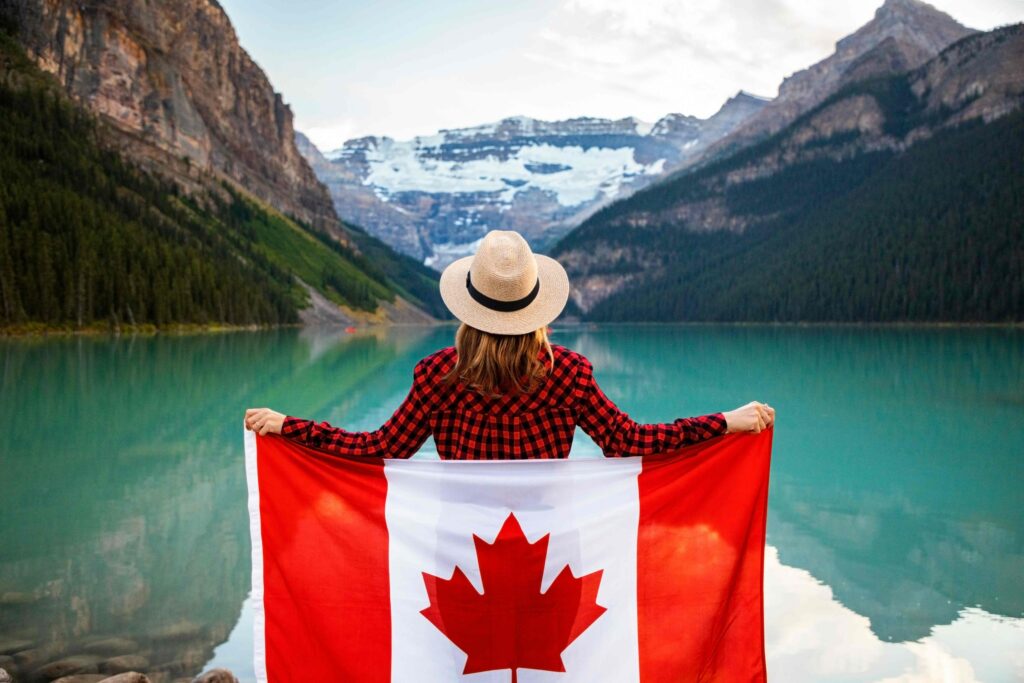Paris is renowned for its romance, history, and culture. See some of the fun facts about Paris that ...
Travel Guides
Canada is massive, stunning, and completely different depending on when you go. Pick the right season, and it’s magic. Pick wrong, and you’ll battle crowds or freezing temperatures.


Canada is a country of extremes, but in the best possible way. In the span of a single year, it transforms from snow-covered wonderlands and frozen lakes to sun-drenched trails, thundering waterfalls, and coastlines lit by endless daylight. Knowing the best time to visit Canada will significantly reshape your trip.
If you choose the right season, Canada will give you exactly what you’re after—whether it’s golden forests, budget-friendly cities, alpine adventures, or festival-packed weekends.
If you pick wrong, you could land in the middle of closed hiking trails, overpriced hotels, or biting cold. This is your clear, season-by-season breakdown of when to go, what to expect, and how to match your trip with the Canada you really want to experience.
With its vast landscapes and varied climates, Canada offers something unique every season. Here’s a breakdown of the best seasons to visit, depending on what you’re seeking.
Summer is when Canada fully embraces visitors. The weather is warm across most of the country, the sun sticks around late into the evening, and nearly every park, museum, and festival is in full swing.
From hiking in Banff to kayaking in Nova Scotia, this is when outdoor adventures are at their most accessible—and most crowded. You’ll enjoy temperatures in the 60–80°F range (15–27°C) and endless daylight, especially in the north where the sun can set as late as 10 PM.
But that access comes at a price. Summer is also the most expensive and the busiest time to visit. Flights are full, hotel prices surge, and national parks can feel more like festivals than wilderness escapes.
As the summer crowds head home and temperatures begin to cool, Canada quietly slips into one of its most stunning seasons. Fall brings a kind of magic that’s hard to overstate—fiery foliage in Ontario and Quebec, crisp air in the Rockies, and a slower, more relaxed pace just about everywhere.
Early fall still feels like summer in many places, especially in September. But as October rolls in, forests explode with color, harvest festivals pop up in rural towns, and travel costs dip. It’s the perfect time to road trip through national parks, visit wine regions, or explore cities without the summer swarm.
What makes fall even more appealing is the balance it strikes: mild weather, lower prices, and open attractions—without the long lines or high-season chaos.
Canada in winter isn’t for everyone—but for those who love snow, it’s a dream. World-class ski resorts like Whistler, Banff, and Mont Tremblant come alive, and even cities like Montreal and Ottawa embrace the cold with festivals, skating rinks, and seasonal charm.
Temperatures can drop well below freezing, especially in January and February. But with the right gear—and the right mindset—you’ll experience a side of Canada that’s both peaceful and exhilarating. Snowshoeing through quiet forests, sipping hot chocolate in cozy cafés, watching the northern lights in the Yukon—these are the moments that define Canadian winter.
That said, travel logistics can get tricky. Roads can be icy, daylight hours are short, and outdoor plans depend heavily on the weather. If you're prepared for the conditions, winter can be one of the most rewarding—and unforgettable—times to visit.
Spring is Canada’s quietest tourist season, making it one of the best times to visit. As the snow melts and nature wakes up, cities become walkable again, flowers bloom in coastal gardens, and prices remain refreshingly low.
April can still be chilly, but by May, temperatures rise, and trails reopen. This is a great time for cultural trips, all without the peak-season rush. You won’t find the full power of summer’s wilderness, but you will find breathing room, fresh air, and great value.
Though timing is key for your trip, Canada offers much more than just its weather. From unique traditions to fascinating history, there's always something new to explore. Check out these interesting facts about Canada before you go!
Canada’s conditions can vary greatly throughout the year, and knowing what to expect will help you plan the perfect getaway."
Here’s a quick overview of Canada’s seasons:
| Season | Months | Average temperatures | Typical weather |
| Summer | June-August | 15°C–27°C (59°F–81°F) | Warm to hot, long sunny days, ideal for outdoor activities |
| Fall | September–November | 5°C–15°C (41°F–59°F) | Crisp temperatures, colorful foliage, moderate rain |
| Winter | December–February | -7°C– -23°C (19°F– -9°F) | Cold, snowy, short days, perfect for winter sports |
| Spring | March–May | 4°C–15°C (39°F–59°F) | Mild, occasional rain, blooming landscapes |
Ice on Whyte Festival (Edmonton) is an international ice sculpture competition where artists create massive frozen artworks along historic Whyte Avenue. It’s great for families and photo opportunities.
Quebec Winter Carnival (Quebec City) is the world's largest winter carnival with an ice palace, snow slides, and mascot Bonhomme. It’s perfect if you want to experience authentic Canadian winter culture.
Winterlude (Ottawa) is the capital's premier winter festival featuring skating on the world's largest skating rink (Rideau Canal) and incredible ice sculptures.
Canadian Music Week (Toronto) is North America's biggest music conference with 800+ artists performing across 40+ venues. Excellent for discovering new music and networking.
Hot Docs Film Festival (Toronto) is North America's largest documentary festival screening 200+ films. Perfect for film lovers wanting to see cutting-edge documentaries.
Canadian Tulip Festival (Ottawa): Over 1 million tulips bloom throughout the capital celebrating Canada-Netherlands friendship. Beautiful for spring photography and family outings.
Dauphin's Countryfest is an annual country music festival held in Dauphin, Manitoba. It features live country music performances, food vendors, and a fun, community-focused atmosphere.
Calgary Stampede (Calgary) is the Greatest Outdoor Show on Earth" featuring world's largest rodeo, chuck wagon races, and authentic cowboy culture and western heritage.
Montreal International Jazz Festival is the world's largest jazz festival with 500+ concerts and 2+ million attendees. Here you’ll find free outdoor shows and world-class musicians.
Canadian National Exhibition (Toronto) is a massive summer fair with rides, concerts, food vendors, and agricultural exhibits. Classic Canadian summer tradition.
Toronto International Film Festival (TIFF) is one of the world's most prestigious film festivals with Hollywood premieres and celebrity spotting. Great for film enthusiasts and star watching.
Nuit Blanche (Toronto) is an all-night contemporary art festival with free exhibitions throughout the city from sunset to sunrise. Unique cultural experience and artistic discovery.
The Grey Cup Festival in Winnipeg is a week-long celebration leading up to Canada's biggest football event. Here you can enjoy live entertainment, interactive games, and fun activities for the whole family.
Christmas Markets (various cities) are traditional European-style markets in Toronto, Vancouver, and Quebec City with local crafts, seasonal treats, and holiday entertainment.
The most affordable time to visit Canada is generally during the shoulder seasons—spring (April to early June) and fall (September to November). During these months, you’ll find lower accommodation rates and cheaper flights, as tourism slows down after the peak summer crowds.
If you're looking for the absolute lowest prices, winter (December to February)—excluding the holiday season—is typically cheaper for hotels and flights, but weather conditions in some parts of the country can be harsh.
Key reasons to visit in the shoulder season:
Since Canada is a vast and diverse country, the time you need will depend on how much of it you plan to see, whether you're focusing on urban experiences, natural wonders, or a combination of both.
Here’s a breakdown to guide you:
Whistler, Canada
This timeframe is ideal if your primary focus is on city exploration. Canada has some of the most vibrant and culturally rich cities in North America, such as Toronto, Vancouver, Montreal, and Ottawa. Each city has its unique offerings.
With 7 to 10 days, you can comfortably visit one or two cities, soaking in the culture, museums, shopping, and dining, while also having some time for nearby day trips. For example, you could pair a visit to Toronto with a day trip to Niagara Falls, or spend a few days exploring Vancouver and then head to Whistler.
Banff National Park, Canada
For those wanting to experience both urban and natural beauty, 10 to 14 days is a perfect balance. You can combine city experiences with trips to natural landmarks such as the Rocky Mountains, Banff National Park, or Niagara Falls.
This amount of time allows you to explore two or more regions of Canada. For example, you could spend a few days in Toronto or Montreal and then fly to the west coast to explore the breathtaking natural landscapes of Vancouver, followed by a trip to the famous Banff National Park.
Toronto, Canada
If you’re limited on time, 3 to 5 days is enough for a quick visit to one city or region. For example, Toronto can be explored in 3 to 5 days, where you can visit iconic attractions like the CN Tower, Royal Ontario Museum, and take a trip to nearby Niagara Falls.
Similarly, Montreal's vibrant arts scene, historic Old Montreal, and excellent food culture can also be experienced within this time frame. However, keep in mind that with this limited time, you won't be able to experience much of the country's natural beauty or explore multiple regions in depth.
Canada's vast size means that the more places you want to see, the more time you’ll need. If your goal is to see both the urban excitement and the natural wonders, the length of your trip should be on the longer side.
No, U.S. citizens do not need a visa or an Electronic Travel Authorization (eTA) to enter Canada for short visits. Whether you're traveling by air, land, sea, or rail, a valid U.S. passport is sufficient for entry. This exemption applies to tourism, business, or family visits of up to six months.
Even if you're transiting through Canada en route to another destination, you do not require an eTA or visa, regardless of your mode of transportation. However, if you're a lawful permanent resident of the United States, you must carry both:
This documentation is required for all methods of travel to Canada, including by air, land, or sea.
Canada is known for having reliable Wi-Fi connectivity, especially in major cities like Toronto, Vancouver, Montreal, and Ottawa. You'll find free Wi-Fi in many public places, such as cafes, restaurants, airports, and libraries.
However, if you are traveling to rural or remote areas, you may encounter limited or slower Wi-Fi connectivity. In such cases, it's advisable to consider getting a local SIM card or renting a mobile hotspot for better and more reliable internet access.
For travelers who want to stay connected without the hassle of changing SIM cards, eSIMs are a fantastic option. Here are some of the best eSIM providers in Canada:
Holafly offers unlimited data eSIM plans tailored specifically for tourists in Canada, making it a fantastic choice for travelers who want uninterrupted mobile access. The activation process is simple, and once the plan is activated, there's no need for recharges, giving you peace of mind throughout your stay.
Nomad provides a variety of eSIM data plans that are customizable based on the duration and data needs of your trip. Their flexible options make it ideal for both short-term and long-term travelers, though the plans don't include unlimited data, and they tend to be pricier.
Airalo is widely recognized for offering affordable eSIM plans with global coverage. With a user-friendly interface, it's great for travelers visiting multiple destinations, as it allows you to purchase eSIMs for various countries. However, internet speeds may be slower in rural or remote areas of Canada.
Comparison of plans and pricing:
| Provider | Plans | Pricing |
| Holafly | Unlimited data | From $7.90 |
| Nomad | 1 GB, 3 GB, 5 GB, 10 GB, 15 GB, 20 GB, 20 GB | From €4.39 to €30.69 |
| Airalo | 1 GB, 2 GB, 3 GB, 5 GB, 10 GB, 20 GB, unlimited | From $6 to $49 |
Which season is the most beautiful in Canada?
The best time to visit is spring (April to June) and fall (September to November), when temperatures are mild, crowds are smaller, and the scenery is breathtaking with blooming flowers or colorful autumn foliage. Summer offers warm weather but is the busiest and most expensive time to visit.
What is the prettiest city to visit in Canada?
The prettiest city in Canada is often considered Vancouver. Nestled between the Pacific Ocean and the Coast Mountain Range, it features stunning natural beauty with lush parks, breathtaking waterfront views, and towering mountains.

